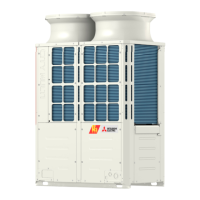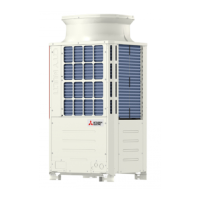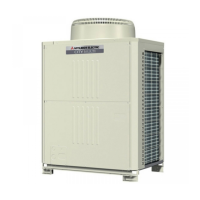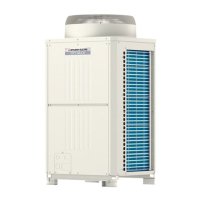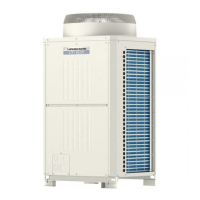How to fix abnormal bus voltage rise in Mitsubishi Electric PURY-P96?
- RRachel HillSep 7, 2025
If your Mitsubishi Electric Air Conditioner is experiencing an abnormal bus voltage rise, monitor and control the voltage output.

How to fix abnormal bus voltage rise in Mitsubishi Electric PURY-P96?
If your Mitsubishi Electric Air Conditioner is experiencing an abnormal bus voltage rise, monitor and control the voltage output.
What to do if Mitsubishi Electric PURY-P96 Air Conditioner has overload protection?
If your Mitsubishi Electric Air Conditioner is experiencing overload protection issues, assess the load conditions and reduce the load if necessary.
How to fix heatsink overheat protection in Mitsubishi Electric PURY-P96?
If your Mitsubishi Electric Air Conditioner is experiencing heatsink overheat protection, check the cooling systems and make sure there is adequate airflow.
How to fix RPM error/motor error in Mitsubishi Electric Air Conditioner?
If you are getting an RPM error or motor error on your Mitsubishi Electric Air Conditioner, check the motor operation. Replace the motor if it is faulty.
How to fix temperature sensor fault in Mitsubishi Electric Air Conditioner?
If there is a temperature sensor fault in your Mitsubishi Electric Air Conditioner, replace the faulty temperature sensors.
How to fix communication error between device and transmission processors in Mitsubishi Electric PURY-P96?
To resolve a communication error between the device and transmission processors in your Mitsubishi Electric Air Conditioner, check the wiring connections and replace any damaged cables.
What to do if Mitsubishi Electric Air Conditioner has water supply cutoff?
If the water supply is cutoff to your Mitsubishi Electric Air Conditioner, verify that the water supply is active and the connections are secure.
How to fix transmission power supply fault in Mitsubishi Electric PURY-P96 Air Conditioner?
If there is a transmission power supply fault in your Mitsubishi Electric Air Conditioner, inspect the power supply connections.
What to do if Mitsubishi Electric PURY-P96 has discharge temperature fault?
If your Mitsubishi Electric Air Conditioner is showing a discharge temperature fault, inspect the discharge temperature sensor for failure.
How to fix serial communication error in Mitsubishi Electric Air Conditioner?
To resolve a serial communication error in your Mitsubishi Electric Air Conditioner, check the wiring connections and replace any damaged cables.
| Brand | Mitsubishi Electric |
|---|---|
| Model | PURY-P96 |
| Category | Air Conditioner |
| Language | English |
Read manual, keep for reference, and observe safety precautions for user's safety.
Use qualified technician, ensure stable mounting, correct cables, and consider seismic measures.
Ventilate rooms with leaks, avoid unit modifications, do not touch hot/cold parts, use dedicated electrical circuits.
Use correct refrigerant type, secure terminal covers, and handle high-voltage parts with extreme care.
Use specific R410A piping, keep clean, store indoors, and seal ends to prevent contamination.
Charge liquid refrigerant, use vacuum pump with check valve, and use R410A-exclusive tools.
Avoid charging cylinders and mixing refrigerants; ensure oil compatibility.
Avoid gas leak areas, unusual environments, and hospitals; ensure proper drainage.
Unit is not for preserving food or artifacts; avoid unusual environments.
Proper grounding, wire tension, earth leakage breaker, correct wire/fuse types, avoid water contact.
Check installation base, install drain pipes correctly, handle products carefully, dispose of packing safely.
Turn on unit 12 hrs prior, avoid wet hands, do not touch pipes, operate with panels, use air filters.
Check refrigerant type, symptoms, safety, tools, pipes, and leaks.
Necessary tools, piping materials, storage, processing, and brazing procedures.
Air tightness test, vacuum drying, refrigerant charging, leak remedies, and refrigerant characteristics.
Notes on refrigerating machine oil for HFC systems and effects of contaminants.
Compatible indoor units, cable types, and maximum allowable lengths.
Switch settings, address settings, and sample system connection diagrams.
Outlines pipe length restrictions for systems with BC controllers.
Identifies major components and illustrates the refrigerant circuit.
Details components within outdoor unit and BC controller control boxes and circuit boards.
Illustrates the components of the BC controller for different models.
Compares MA and ME remote controller functions, specifications, and selection criteria.
Details group, interlock, and address settings for ME and MA remote controllers.
Explains usage of the built-in temperature sensor on remote controllers.
Provides detailed electrical wiring diagrams for various outdoor unit models.
Shows electrical wiring diagrams for BC controllers and transmission boosters.
Illustrates refrigerant circuit diagrams for different outdoor unit models.
Details the functions and specifications of key refrigerant circuit components.
Explains dipswitch functions and factory settings for outdoor units and remote controllers.
Covers control methods, startup sequences, and operation modes for outdoor units.
Explains control of solenoid valves, LEV, and SVM based on operation modes.
Provides flowcharts for mode determination and operation sequences.
Lists essential items to check before performing a test run.
Details the step-by-step method for conducting a test run.
Explains refrigerant characteristics and guides on adjusting refrigerant amount.
Lists normal operating symptoms that might otherwise be mistaken for faults.
Provides reference data for standard operating conditions across different models.
Lists all error codes and provides guidance on responding to remote controller error displays.
Explains how to investigate transmission wave shapes and noise interference.
Provides detailed troubleshooting steps for principal parts like sensors, valves, and motors.
Guides on compressor replacement and troubleshooting inverter-related problems.
Details procedures for finding and repairing refrigerant leaks.
Explains how to interpret numerical values and flag displays on the service monitor.
Describes information displayed on the monitor during initial setup.
Explains how the unit stores and displays time and date data.
Table mapping SW1 settings to display values and remarks for various items.


